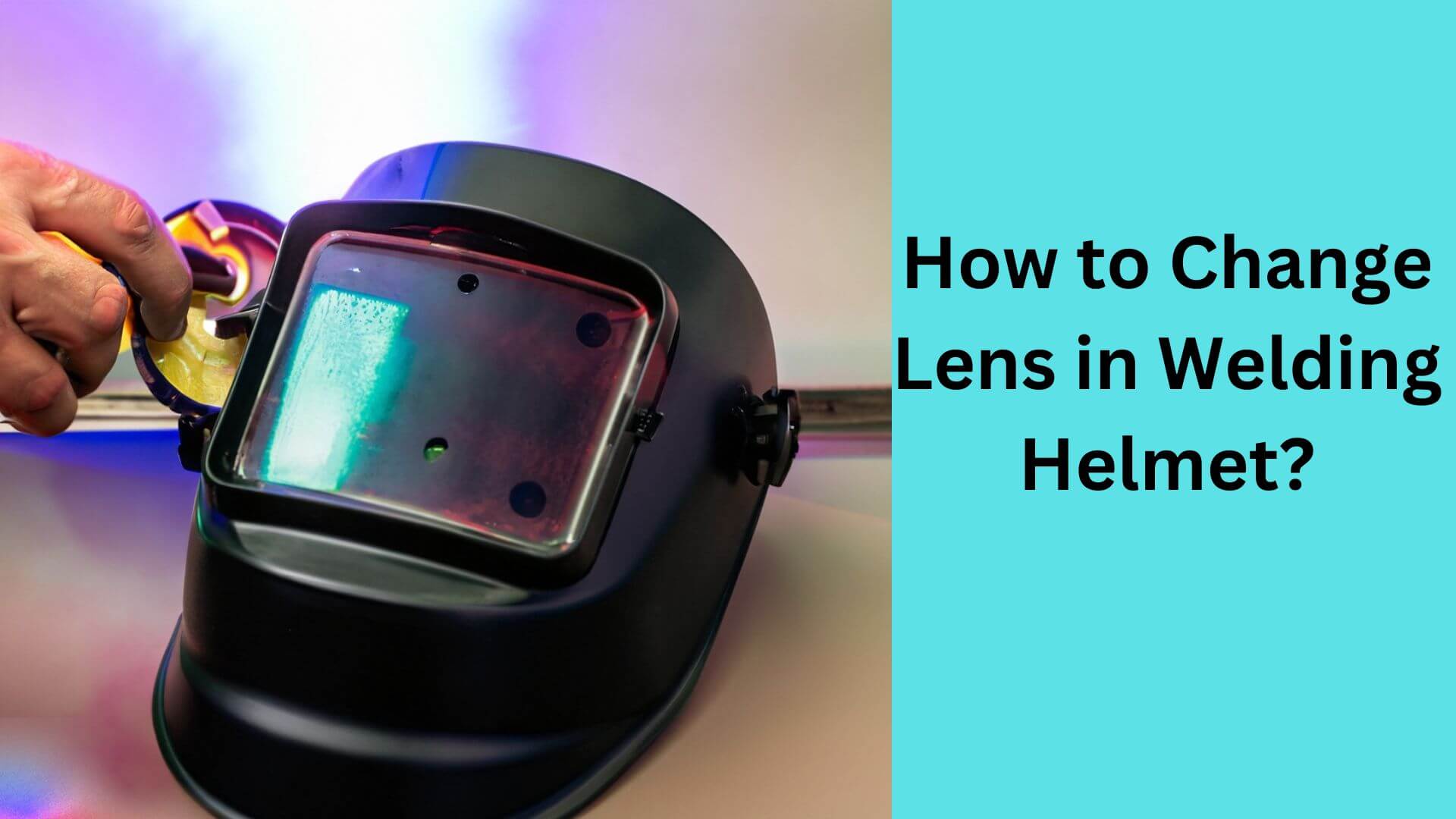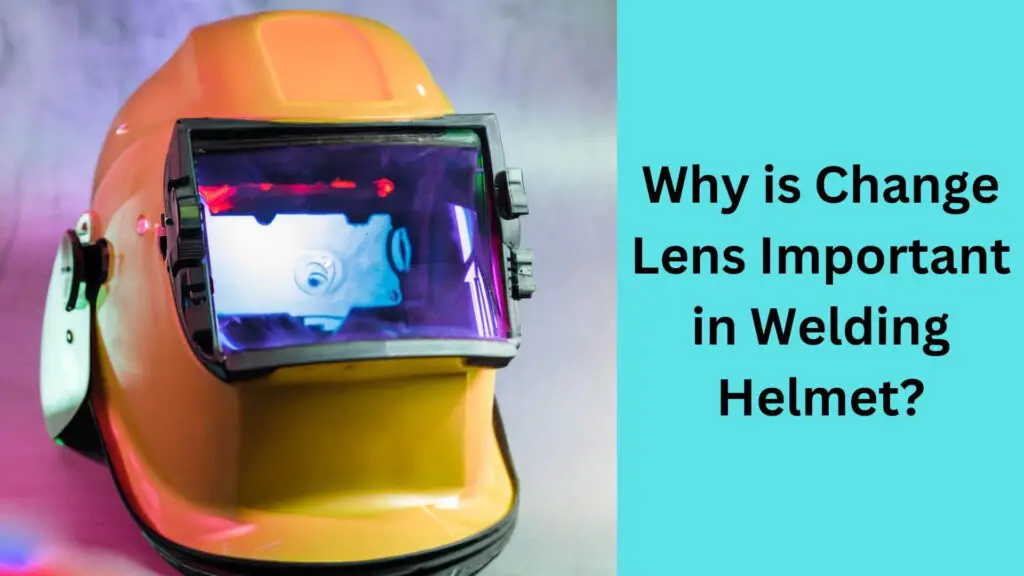How to Change Lens in Welding Helmet? Lens Swap 101

Attention all welders! Have you ever struggled to change the lens in your welding helmet? You’re not alone. This task can be daunting, especially if you’re new to the craft. But fear not; I’ve got you covered.
To change the lens in a welding helmet: first, unscrew the lens cover, then remove the old lens and pry off the retaining clip, insert the new lens, and replace the retaining clip before screwing it back on the lens cover. Welding helmets are an essential part of any welder’s safety gear.
In this blog post, we’ll guide you through changing the lens in your welding helmet step-by-step.
You’ll learn about the different types of lenses and which one is best suited for your welding needs.
I’ll also provide helpful tips to make the process easier and more efficient. So, if you’re ready to take your welding skills to the next level, let’s dive in and learn how to change the lens in a welding helmet.
What is Change Lens in Welding Helmet?

Change Lens in welding helmet is a process of removing and replacing the filter lens in the welding helmet. It is done to ensure that the welder’s eyes are protected from harmful radiation emitted during welding.
The process involves unscrewing the lens cover and removing the old lens. The new lens is inserted, and the cover is screwed back in place.
It is important to note that the lens should be replaced regularly as it can become scratched or damaged over time, reducing its effectiveness.
The frequency at which the lens should be changed depends on the welding type and frequency.
Welders are instructed to follow the manufacturer’s guidelines for their specific helmet model. In addition, it is crucial to use the correct lens shade for the welding type to ensure maximum protection for the welder’s eyes.
Read More: Grind Mode Deactivation: Elevate Your Welding Helmet Skills
Why is Change Lens Important in Welding Helmet?

Here are 5 reasons why changing lenses in a welding helmet are essential:
1. Protects your eyesight: Welding produces intense light that can damage your eyesight if you don’t wear proper eye protection. You can protect your eyes from harmful UV and IR radiation by changing lenses.
2. Improves visibility: Different welding applications require different levels of shading. Changing lenses allows you to adjust the shade level to improve visibility and reduce eye strain.
3. Increases productivity: You can work faster and more efficiently with the right lens. By changing lenses, you can achieve optimal clarity and focus, which can help you complete your welding tasks more quickly.
4. Saves money: By changing lenses, you can extend the life of your welding helmet. If you use the same lens for all welding applications, it can wear out faster than if you use the appropriate lens for each job.
5. Enhances safety: Welding can be hazardous, but changing lenses can help reduce the risk of accidents. By ensuring that you have the right lens for the job, you can work more safely and with greater confidence.
Read More: Quick and Effective Techniques for Taking Out Welding Helmet Inserts
Preparing For The Lens Change
Preparing for a lens change can be overwhelming, but it can be a breeze with a few simple steps. Here’s how.
1. Gather The Necessary Supplies
Before you start changing the lens in your welding helmet, having all the necessary supplies within reach is crucial. Here is what you will need:
- Replacement lens
- Screwdriver or pliers (depending on the type of helmet)
- Cleaning cloth
- Gloves
- Safety glasses
2. Ensure Your Work Area Is Clean And Safe
Ensure your workspace is clean and free of any dust or debris that can get into the helmet during the lens change process. Here are some tips to help you prepare your workspace:
- Clear the work surface of any unnecessary items
- Clean the work surface with a damp cloth to remove any dust or debris
- Make sure the helmet is in a stable position and won’t tip over during the process
Additionally, ensure your workspace is safe by taking the following steps:
- Turn off the welding machine
- Notify coworkers that you will be working on your helmet.
- Wear appropriate safety gear, including gloves and safety glasses
These steps will ensure a smooth and safe lens-changing process for your welding helmet.
Read More: Assembling Your Welding Helmet: Expert Tips for Ultimate Protection
Step-By-Step Guide To Changing Welding Helmet Lenses
Changing the lens of a welding helmet is essential to ensure the welder’s safety and visibility, as the helmet’s lens helps protect the eyes from the welding arc’s harmful rays.
Changing the welding helmet’s lens yourself might seem daunting, but it can be done with a few simple steps.
Here’s a step-by-step guide to changing welding helmet lenses.
Step1: Removing The Old Lens
Before installing a new lens, the old lens needs to be removed. Follow these steps to remove the old lens:
- Turn off the welding machine and remove the helmet.
- Wear gloves to protect your hands as you handle the lens.
- Identify the lens retaining mechanism, which typically includes tabs, knobs, and screws.
- Use a screwdriver or pliers (depending on the mechanism) to remove the retaining mechanism and release the lens.
- Carefully remove the old lens from the helmet.
Step 2: Preparing The New Lens
Once you have removed the old lens, it’s time to prepare the new lens for installation. Follow these steps:
- Check the new lens for flaws, cracks, or scratches. If it has any, do not use it.
- Determine the correct lens shade that you need for your welding process. Different welding processes require different lens shades, so use the right one.
- If necessary, remove any protective film covering the new lens.
Step 3: Installing The New Lens
With the old lens removed and the new lens prepared, it’s time to install it. Follow these steps:
- Take the new lens and attach any required components, such as gaskets or spacers, that came with the new lens.
- Insert the new lens into the helmet’s lens holder.
- Align the lens so it sits correctly within the holder.
- Reattach the retaining mechanism and secure the new lens.
- Test the helmet by turning it on and ensuring the new lens blocks the harmful welding rays.
Congratulations! You’ve successfully changed the lens in your welding helmet. It’s important to note that you should check your welding helmet frequently to ensure the lens is secure and not damaged.
Remember to use the correct lens shade for your welding process, and always prioritize your safety while working.
Read More: How to Install Cheater Lens in Welding Helmet?
Bonus Tips For Maintaining Your Welding Helmet Lenses
Welding helmets are essential safety gear in any welding job. As a welder, you must ensure that your welding helmet is always in tip-top shape to protect you from the dangers of welding. One way to do that is to change your lenses regularly.
Here I will discuss some tips for maintaining your welding helmet lenses to ensure your safety while welding.
Tips 1: Cleaning Your Lenses
Your helmet’s lenses can get dirty during welding, making it challenging to see what you are doing. Cleaning your lenses is a crucial step in maintaining your helmet. Here are some tips for cleaning your welding helmet lenses:
- Use a microfiber cloth to clean the lenses. This cloth can effectively remove dirt and debris from the lenses without scratching them.
- Avoid harsh chemicals or abrasive materials that damage the lenses’ protective coating.
- Use a specialized lens cleaner for welding helmets to clean stubborn stains or residue from the lenses.
- Clean your lenses regularly to ensure that they are always clean and clear.
Tips 2:Storing Your Helmet Properly
Proper helmet storage is another essential aspect when maintaining your welding helmet. Failure to store your helmet correctly can lead to scratches, cracks, or other lens damage. Here are some tips for storing your helmet correctly:
- Store your helmet in a cool, dry place away from direct sunlight.
- Use a specialized helmet bag or case to protect your helmet from dust and debris.
- Store your helmet where it won’t fall or be knocked down.
- Keep your helmet away from chemicals, solvents, or other harsh substances.
Maintaining your welding helmet lenses is essential for your safety while welding. Regular cleaning and proper storage help extend the life of your lenses and maintain their effectiveness. Follow the tips above to keep your helmet in tip-top shape and ensure the best protection.
Read More: How to Change Batteries in a Welding Helmet?
Common Mistakes To Avoid
Welding is a skilled profession that requires the proper equipment and safety measures. A welding helmet is one of the essential pieces of equipment a welder must have. This helmet helps protect the welder’s eyes and face from sparks and harmful radiation.
Changing the lens is a crucial yet often overlooked aspect of maintaining the helmet’s safety features. In this section, we will explore the common mistakes to avoid when changing the lens in a welding helmet.
1. Using The Wrong Lens
One of the most significant mistakes people make when changing the lens in a welding helmet is using the wrong lens. Different types of lenses are available in the market, each serving a specific purpose. Using the wrong lens can compromise your safety and lead to serious injuries.
Here are some things to keep in mind when selecting the right lens:
- Check the welding helmet manual for the recommended lens shade number for the type of welding you will do.
- Choose a lens that meets the industry standards, such as ansi z87.1.
- Ensure that the lens fits your helmet correctly.
2. Incorrectly Installing The Lens
Another common mistake people make when changing the lens in a welding helmet is incorrectly installing the lens.
Installing the lens wrong can interfere with your vision, put you at risk of injury, and damage the lens. Here are some things to keep in mind when installing a lens:
- Clean the lens and the helmet thoroughly before installing the lens.
- Ensure that you have the right lens for your helmet.
- Install the lens according to the manufacturer’s instructions.
- Confirm that the lens is secure and in the right position before using the helmet.
Changing the lens in a welding helmet is crucial to the welder’s safety. By avoiding the common mistakes mentioned above, welders can protect themselves from the dangers of welding. Remember always to use the right lens and install it correctly.
Stay safe, and happy welding!
Read More: How To Use Welding Helmet?
Frequently Asked Questions Of How To Change Lens In Welding Helmet
How Do You Remove The Lens From A Welding Helmet?
To remove the lens from a welding helmet, loosen the retaining mechanism and gently pop out the lens.
Can I Replace My Welding Helmet Lens With Any Brand?
No, it’s recommended that you replace your welding helmet lens with the same brand of lens as your helmet.
When Should I Change My Welding Helmet Lens?
You should change your welding helmet lens when it becomes scratched, cracked, or discolored, as this can affect your visibility.
How Often Should I Clean My Welding Helmet Lens?
You should clean your welding helmet lens after each use to ensure visibility and to extend the life of your helmet.
How Do I Know If The Replacement Lens Is The Right Size?
You can check the size of the original lens in your helmet and buy a replacement lens with the exact dimensions.
Last Word
After going through the steps outlined in this article, changing the lens in your welding helmet should no longer be daunting. Safety should always be paramount when welding; a clear, undamaged lens is essential.
It is important to assess the condition of your lens regularly and replace it when needed. The steps involved in changing the lens may vary slightly depending on your helmet, but the general principles remain the same.
Take your time, be careful and follow the steps closely. With practice, changing the lens will become second nature. Always remember that proper lens maintenance can contribute to your safety and the quality of your welding work. So, what are you waiting for?
Grab your welding helmet, and let’s get started!

Hey, I’m Hrithik Hossain. I am the head of helmethacks.com, which specializes in safety helmets. I am looking to connect with anyone interested in purchasing a helmet or who has any questions about different types of helmets. I have over 8 years of experience as a helmet expert, and I can’t wait to help you find the perfect helmet for you. I can help you with any questions regarding helmets, from the best brands to fitting, style, and more! I really enjoy keeping people safe by ensuring they have the best protection possible.







